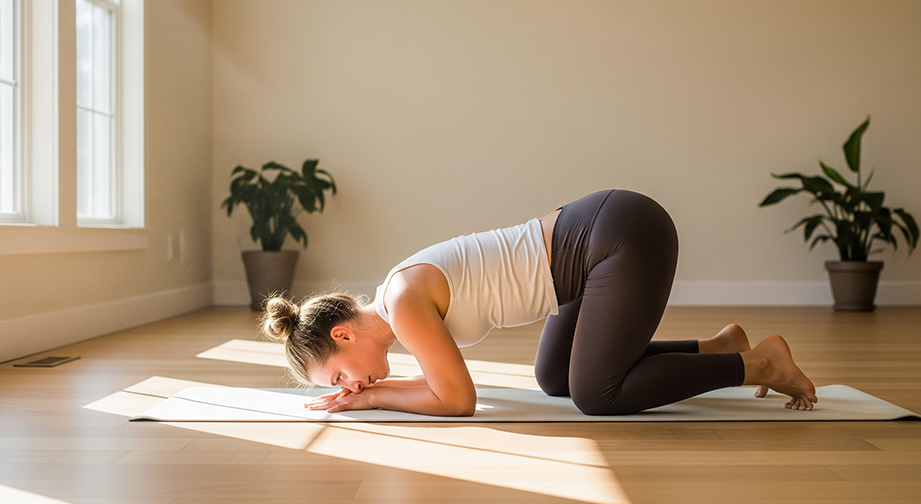Mandukasana (Frog Pose): How to Practice, Benefits, and Safety Tips
Introduction
Mandukasana (Sanskrit: ????????), also known as Frog Pose (sitting variation), is a beginner-friendly yoga asana that deeply opens the hips and stretches the lower back. In Sanskrit, manduka means “frog”, and asana means “posture” or “seat”. This calming yoga pose is especially known for relieving tension, increasing mobility, and grounding your mind and body.
If you’ve ever felt stiff after sitting too long or want to soothe a tight lower body after a long day, Mandukasana could become your new favorite yoga posture.
Step-by-Step Guide: Mandukasana (Frog Pose)

- Start on All Fours. Begin by coming onto your hands and knees (tabletop position) on a yoga mat.
- Widen the Knees. Gently slide your knees apart as wide as comfortable, keeping your ankles aligned with your knees and your feet flexed (toes pointing out).
- Lower Your Forearms. Bring your forearms to the mat, elbows under the shoulders. Palms can rest flat or together in prayer.
- Straighten Your Spine. Keep your head and neck in a neutral position, gaze slightly forward or downward.
- Breathe Deeply. Inhale to lengthen the spine, and exhale to ease your hips back and down, surrendering into the stretch.
- Hold: Stay in Mandukasana for 30-60 seconds or as comfortable. Repeat up to 2 rounds.
- To release: Bring your knees back together gently and return to tabletop or Child's Pose.
Breathing Pattern
- Inhale: Lengthen your spine and expand the chest.
- Exhale: Soften your hips towards the mat, deepening into the stretch.
- Maintain a slow, natural breath throughout the pose.
Modifications & Variations
- For Beginners: Place a folded blanket or bolster under your knees for extra padding. Don’t overstretch—keep knees closer together if needed.
- For Advanced Practitioners: Widen knees further, and lower the chest closer to the floor. Extend arms forward for a more intense hip opener.
{C}
Alignment & Safety Tips for Mandukasana
- Alignment Cues:
- Keep ankles in line with knees, toes pointing outward.
- Maintain a straight, neutral spine.
- Engage your core gently to support the lower back.
- Common Mistakes:
- Overstretching knees – only go as far as comfortable.
- Collapsing the lower back – keep core engaged.
- Forgetting to breathe deeply – keep breath natural and even.
- Safety Precautions:
- Avoid Mandukasana if pregnant, have knee injuries, hip pain, or recent lower body surgeries.
- Never force your knees or hips wider than feels comfortable.
{C}
Benefits of Mandukasana (Frog Pose)
- Physical Benefits:
- Increases hip flexibility
- Stretches inner thighs, groin, and lower back
- Improves posture and mobility
- May stimulate digestion by compressing the abdomen
- Mental Benefits:
- Relieves stress and tension
- Promotes mindfulness and calm
- Encourages deep, steady breathing
- Energy / Chakra Connection:
- Activates the Sacral (Svadhisthana) chakra, aiding creativity and emotional balance.
{C}
Contraindications
- Do NOT practice Mandukasana if you:
- Are pregnant (choose Butterfly Pose or a gentle supine hip opener instead).
- Have severe knee, hip, or groin injuries.
- Recently had abdominal or lower body surgery.
- Safe Alternatives: Supta Baddha Konasana (Reclined Butterfly), Supported Child’s Pose.
Beginner’s Tips & Variations
- Props: Use a yoga bolster, folded blanket, or extra mat under knees for comfort. A block under the chest gives additional support if needed.
- Gentle Variation: Keep knees closer and rest hips higher. Only lower to forearms if comfortable.
- Advanced Variation: Bring chest lower, extend arms forward, or try a prone (lying) Frog Pose for an extra stretch.
How to Include Mandukasana in Your Yoga Flow
- Best Placement: Mandukasana is ideal as a main practice pose or during cool-down, especially after warming up the hips.
- Pose Pairing: Works well after Cat-Cow Pose or Pigeon Pose, and before/after Child’s Pose for a restorative finish.
Mind-Body Connection
While holding Mandukasana, bring your attention to the sensations in your hips and breath. This is a great opportunity to let go of lingering stress and deepen your self-awareness. As this pose stimulates the sacral chakra, it also supports emotional release and renewal.
Summary Box
- Asana Name: Mandukasana (Frog Pose, ????????)
- Level: Beginner
- Focus Areas: Hips, Inner Thighs, Lower Back
- Duration: 30–60 seconds per round, 1–2 rounds
- Best Time to Practice: Morning or Evening, after warming up
Frequently Asked Questions
- Is Mandukasana safe for beginners?
- Yes! Always use props if needed and avoid overstretching. Start with shorter holds and build up gradually.
- Can Mandukasana help with hip tightness?
- Absolutely. Regular practice of Mandukasana (Frog Pose) gently increases hip flexibility and releases tension in the lower body.
- What if my knees hurt in this pose?
- Add extra padding, keep the knees closer together, and back off if there’s sharp pain. Try alternatives like Supta Baddha Konasana if needed.
Practice Mandukasana (Frog Pose) with care and patience—every body is different, so honor your unique flexibility and range of motion. Soon, you’ll discover the calming, balancing effects of this rejuvenating yoga posture!